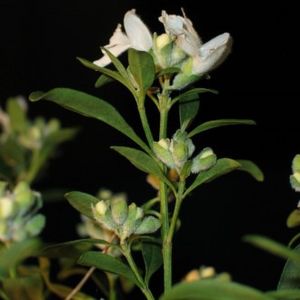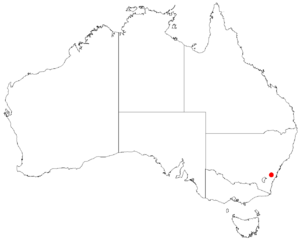Prostanthera conniana facts for kids
Quick facts for kids Prostanthera conniana |
|
|---|---|
 |
|
| In Bungonia National Park | |
| Scientific classification | |
| Genus: |
Prostanthera
|
| Species: |
conniana
|
 |
|
| Occurrence data from AVH | |
Prostanthera conniana is a species of flowering plant that is endemic to New South Wales. It is an erect, open shrub with branchlets that are square in cross-section, narrow egg-shaped to narrow oblong leaves, and white flowers with bright yellow markings on the throat, the flowers arranged in groups of four to eight.
Description
Prostanthera conniana is an erect, open shrub that typically grows to a height of 1.5–3.5 m (4 ft 11 in – 11 ft 6 in) with four-sided branchlets. Its leaves are narrow egg-shaped to narrow oblong, 16–24 mm (0.63–0.94 in) long and 3.5–6.5 mm (0.14–0.26 in) wide on a petiole 1.5–3.5 mm (0.059–0.138 in) long, and with glands on both sides. The flowers are arranged in groups of four to eight, the sepals green, sometimes with a maroon tinge. The petals are 11–16 mm (0.43–0.63 in) long and white, sometimes with a pale mauve tinge and there are bright yellow marking on the throat of the petal tube. Flowering occurs from November to December.
Taxonomy and naming
Prostanthera conniana was first formally described in 2015 by Trevor C. Wilson and others in the journal Telopea. The specific epithet (conniana) honours Barry Conn and his wife Helen.
Distribution and habitat
This mint bush grows on steep rocky slopes in low, open scrub or woodland in four sites near the Shoalhaven River in Bungonia National Park.

